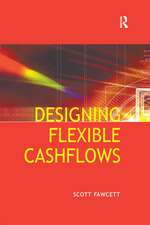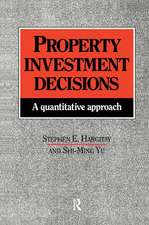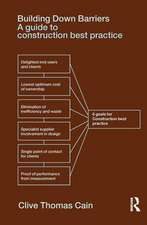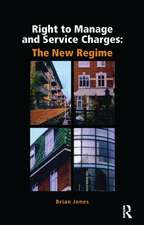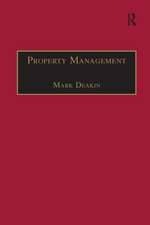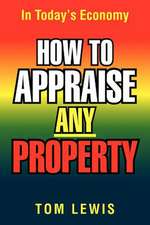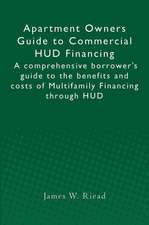Public Consultation and Community Involvement in Planning: A twenty-first century guide
Autor Penny Norton, Martin Hughesen Limba Engleză Hardback – 11 iul 2017
The book begins with a definition of consultation and community involvement and an explanation of their role within the development process, before going on to clarify the legal, ethical, practical and ideological concerns to be addressed by the consultation process. Consultation strategy is explored step by step, and social media and online consultation is explored in detail. This is the first comprehensive guide to modern public consultation within the UK development sector and will be essential reading for developers, students and planners.
| Toate formatele și edițiile | Preț | Express |
|---|---|---|
| Paperback (1) | 372.97 lei 3-5 săpt. | +27.23 lei 6-10 zile |
| CRC Press – 7 iul 2017 | 372.97 lei 3-5 săpt. | +27.23 lei 6-10 zile |
| Hardback (1) | 713.04 lei 6-8 săpt. | |
| CRC Press – 11 iul 2017 | 713.04 lei 6-8 săpt. |
Preț: 713.04 lei
Preț vechi: 954.71 lei
-25% Nou
Puncte Express: 1070
Preț estimativ în valută:
136.46€ • 148.17$ • 114.62£
136.46€ • 148.17$ • 114.62£
Carte tipărită la comandă
Livrare economică 23 aprilie-07 mai
Preluare comenzi: 021 569.72.76
Specificații
ISBN-13: 9781138680142
ISBN-10: 1138680141
Pagini: 408
Ilustrații: 76
Dimensiuni: 156 x 234 mm
Greutate: 0.7 kg
Ediția:1
Editura: CRC Press
Colecția Routledge
ISBN-10: 1138680141
Pagini: 408
Ilustrații: 76
Dimensiuni: 156 x 234 mm
Greutate: 0.7 kg
Ediția:1
Editura: CRC Press
Colecția Routledge
Public țintă
Postgraduate, Professional, Professional Practice & Development, and UndergraduateCuprins
List of figures
Foreword
Preface
Acknowledgements
Chapter 1 Introduction
Part One: the context of consultation today
Chapter 2 A Brief History of Community Engagement in Planning
Chapter 3 The Political Climate for Community Engagement Today
Chapter 4 Societal Change and Consultation
Chapter 5 The Impact of the Internet on Consultation
Part Two: the planning process
Chapter 6 The Planning Process and the Role of Consultation
Chapter 7 The Formulation of a Local Plan
Chapter 8 Neighbourhood Planning
Chapter 9 Localism and New Community Rights
Chapter 10 The Process of a Planning Application
Chapter 11 The role of local authorities in considering and determining planning applications
Chapter 12 Appeals and Public Inquiries
Chapter 13 Consulting on a Nationally Significant Infrastructure Project (NSIP)
Part Three: communications strategy and tactics
Chapter 14 Strategy Development
Chapter 15 Tactics to Inform and Engage
Chapter 16 New Consultation Tactics
Chapter 17 Analysis, Evaluation and Feedback
Chapter 18 Reducing Risk in Consultation
Part Four: post planning
Chapter 19 Community Relations During Construction
Chapter 20 Community Involvement Following Construction
Chapter 21 Conclusion
Appendix 1 Timeline of political events impacting on consultation
Appendix 2 Examples of material and non material planning considerations
Appendix 3 Community involvement strategy outline
Appendix 4 Sample Content for Consultation Websites User Guides
Glossary
Further reading
Index
Foreword
Preface
Acknowledgements
Chapter 1 Introduction
Part One: the context of consultation today
Chapter 2 A Brief History of Community Engagement in Planning
Chapter 3 The Political Climate for Community Engagement Today
Chapter 4 Societal Change and Consultation
Chapter 5 The Impact of the Internet on Consultation
Part Two: the planning process
Chapter 6 The Planning Process and the Role of Consultation
Chapter 7 The Formulation of a Local Plan
Chapter 8 Neighbourhood Planning
Chapter 9 Localism and New Community Rights
Chapter 10 The Process of a Planning Application
Chapter 11 The role of local authorities in considering and determining planning applications
Chapter 12 Appeals and Public Inquiries
Chapter 13 Consulting on a Nationally Significant Infrastructure Project (NSIP)
Part Three: communications strategy and tactics
Chapter 14 Strategy Development
Chapter 15 Tactics to Inform and Engage
Chapter 16 New Consultation Tactics
Chapter 17 Analysis, Evaluation and Feedback
Chapter 18 Reducing Risk in Consultation
Part Four: post planning
Chapter 19 Community Relations During Construction
Chapter 20 Community Involvement Following Construction
Chapter 21 Conclusion
Appendix 1 Timeline of political events impacting on consultation
Appendix 2 Examples of material and non material planning considerations
Appendix 3 Community involvement strategy outline
Appendix 4 Sample Content for Consultation Websites User Guides
Glossary
Further reading
Index
Recenzii
'This book is a very comprehensive overview of the historical background, the obstacles and the democratic legitimacy challenges that come with consultation and community involvement in the changing world of planning, community relations and corporate social responsibility. It offers a tried and tested approach to citizen engagement strategies, informed by a strong theoretical grounding and years of experience on the ground, and provides excellent insights into best practice, demonstrated through a range of projects.' – Adrian Penfold OBE, Head of Planning, British Land
'For those involved in promoting Nationally Significant Infrastructure Projects (NSIPs) through the Development Consent Order (DCO) process under the Planning Act 2008 this publication provides a very good account of the stakeholder engagement and public consultation necessary to meet requirements and achieve a successful outcome. Information and guidance on good practice is presented in a clear, concise and informative way which is readily accessible to busy practitioners.' – Paul White, Technical Director and EIA Technical Authority in the Infrastructure Division at Atkins Ltd
'With the increasing demands being placed upon the planning system for local accountability to be at the forefront of planning practice and decision-making, the process of involving the community in planning can frequently be treated as a science. Penny and Martin’s book reminds us that engaging with individuals and communities is still very much an art and requires imagination and creativity to both inform and engage effectively. There is a wealth of experience and best practice contained within this book that shows us what has worked and importantly to inspire and encourage us to continue to search for new and innovative ways to engage individuals in the planning and building of our future communities.' – Will Cousins, Partner, David Lock Associates
'Perhaps the most remarkable change in planning since the 1960s has been the growing appetite for ordinary people to want to get involved in the planning process. Yet for too long developers have just played lip service to this valid interest. Having worked with Penny over the years I have greatly admired her approach and here it is described both theoretically and through wide-ranging examples. It is the antithesis of the ‘dark art’ of spin so often associated with communication in planning. Penny shows how a considered approach can keep dialogue focused and constructive while both capitalising on modern technology and managing expectations. What comes across is a respect and empathy for consultees that makes her approach so effective in bridging the divide between developer and community.' – Stuart Robinson, Freelance Planning, Placemaking and Development consultant and previously Executive Director and Chairman of Planning at CBRE
"This book is a major achievement and Planning Schools should make it compulsory reading." —The Consultation Institute, December 2017
'For those involved in promoting Nationally Significant Infrastructure Projects (NSIPs) through the Development Consent Order (DCO) process under the Planning Act 2008 this publication provides a very good account of the stakeholder engagement and public consultation necessary to meet requirements and achieve a successful outcome. Information and guidance on good practice is presented in a clear, concise and informative way which is readily accessible to busy practitioners.' – Paul White, Technical Director and EIA Technical Authority in the Infrastructure Division at Atkins Ltd
'With the increasing demands being placed upon the planning system for local accountability to be at the forefront of planning practice and decision-making, the process of involving the community in planning can frequently be treated as a science. Penny and Martin’s book reminds us that engaging with individuals and communities is still very much an art and requires imagination and creativity to both inform and engage effectively. There is a wealth of experience and best practice contained within this book that shows us what has worked and importantly to inspire and encourage us to continue to search for new and innovative ways to engage individuals in the planning and building of our future communities.' – Will Cousins, Partner, David Lock Associates
'Perhaps the most remarkable change in planning since the 1960s has been the growing appetite for ordinary people to want to get involved in the planning process. Yet for too long developers have just played lip service to this valid interest. Having worked with Penny over the years I have greatly admired her approach and here it is described both theoretically and through wide-ranging examples. It is the antithesis of the ‘dark art’ of spin so often associated with communication in planning. Penny shows how a considered approach can keep dialogue focused and constructive while both capitalising on modern technology and managing expectations. What comes across is a respect and empathy for consultees that makes her approach so effective in bridging the divide between developer and community.' – Stuart Robinson, Freelance Planning, Placemaking and Development consultant and previously Executive Director and Chairman of Planning at CBRE
"This book is a major achievement and Planning Schools should make it compulsory reading." —The Consultation Institute, December 2017
Descriere
Property Consultation and Community Engagement is a handy introduction to public consultation for developers, students and planners. The past decade has seen a complete transformation in consultation and community relations in the UK, from increased requirements to consult, to the introduction of Neighbourhood Planning and a revolution in online communication. This book takes readers through consultation from the basics through to emerging trends, demonstrating how a successful consultation process benefits both developers and the local community. This is the first comprehensive guide to modern public consultation within the UK development sector and will be essential reading for developers, students and planners.



